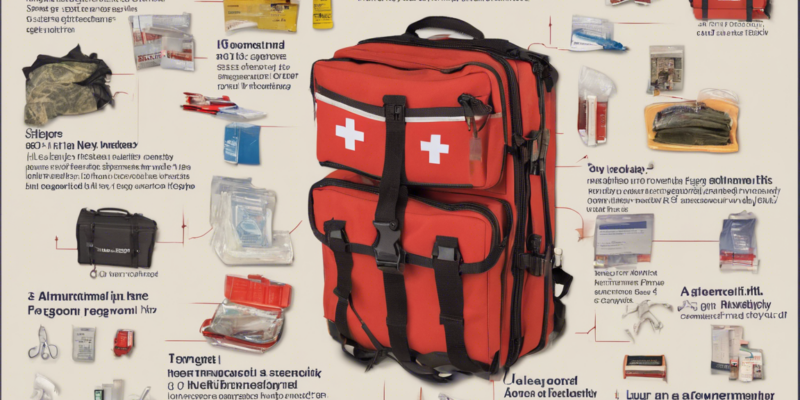Introduction
In times of emergency or crisis, having an emergency kit prepared can make a significant difference in ensuring your safety and well-being. The UK Government provides guidelines on essential items that should be included in an emergency kit to help individuals and families better prepare for unexpected situations, such as severe weather, power outages, or civil disturbances. In this article, we will delve into the recommended items for an emergency kit as outlined by the UK Government, highlighting their importance and how they can help you stay safe and resilient during challenging times.
Why Do You Need an Emergency Kit?
Preparing for Different Scenarios
Emergencies can come in various forms, ranging from natural disasters like floods and storms to man-made crises such as power outages or transportation disruptions. Having an emergency kit ready allows you to be prepared for different scenarios and ensures that you have the necessary supplies on hand to cope with challenges as they arise.
Self-Reliance and Resilience
During an emergency, access to essential services and supplies may be limited. By having an emergency kit prepared, you can enhance your self-reliance and resilience, enabling you to sustain yourself and your family until help arrives. It can alleviate stress and anxiety during uncertain times and give you a sense of control over the situation.
Time and Cost-Effective
Creating an emergency kit in advance is a cost-effective way to prepare for emergencies. It saves you time and resources during a crisis, as you won’t have to scramble to gather supplies at the last minute. A well-stocked emergency kit can also reduce the need to venture out in unsafe conditions to obtain essential items.
Essential Items for an Emergency Kit
Water and Non-Perishable Food
Water: The UK Government recommends storing at least one gallon of water per person per day for drinking and sanitation. Ensure you have an adequate supply of water for each member of your household for at least three days.
Non-Perishable Food: Include a three-day supply of non-perishable food items that do not require refrigeration or cooking, such as canned goods, protein bars, and dried fruits. Choose foods that are high in calories and nutrients to sustain energy levels.
Emergency Supplies
First Aid Kit: A well-stocked first aid kit is crucial in treating minor injuries and illnesses during emergencies. Include items such as bandages, antiseptic wipes, pain relievers, and any prescription medications.
Flashlight and Batteries: Ensure you have a reliable flashlight with extra batteries to provide illumination during power outages or low-light conditions.
Blankets and Warm Clothing: Have blankets, thermal blankets, and extra clothing to keep warm in case of a loss of heating or shelter.
Personal Hygiene Items: Include toiletries, personal hygiene products, and sanitation supplies such as hand sanitizer, wet wipes, and tissues.
Important Documents and Cash
Identification: Keep copies of important documents such as identification, insurance policies, medical records, and emergency contact information in a waterproof container.
Cash: Have some cash on hand in case of ATM outages or electronic payment failures during emergencies.
Tools and Supplies
Multi-Tool: A multi-purpose tool can be invaluable for various tasks, including repairs and opening containers.
Duct Tape and Rope: These versatile items can be used for emergency repairs, securing objects, or creating makeshift shelters.
Whistle: A whistle can help signal for help if you are in distress or need assistance.
Additional Considerations
Special Needs Items: If you have infants, elderly family members, or individuals with specific medical needs, ensure your emergency kit includes items such as baby supplies, medications, and mobility aids.
Pets: Don’t forget to include supplies for your pets, such as food, water, medications, and leashes, in your emergency kit.
Regular Check and Rotation: Periodically check your emergency kit to ensure that supplies are up to date, and rotate perishable items such as food and medications as needed.
FAQs
1. How often should I update my emergency kit?
It is recommended to review and update your emergency kit at least twice a year or whenever there are significant changes in your household, such as new medication needs or additional family members.
2. Can I store my emergency kit in the garage or basement?
While the garage or basement can be suitable storage locations, ensure your emergency kit is kept in a dry, cool, and easily accessible area away from potential hazards like chemicals or pests.
3. Should I include a radio in my emergency kit?
Having a battery-powered or hand-crank radio in your emergency kit is beneficial for receiving important updates and information during emergencies, especially when communication channels are disrupted.
4. How can I involve my family in preparing the emergency kit?
Engage your family members in building the emergency kit by assigning specific tasks to each member, discussing the importance of preparedness, and conducting practice drills to ensure everyone knows where the kit is located and how to use its contents.
5. Can I purchase a pre-made emergency kit instead of assembling one myself?
There are pre-made emergency kits available for purchase, but customizing your own kit allows you to tailor it to your specific needs, preferences, and any unique circumstances or requirements your household may have.


Comments